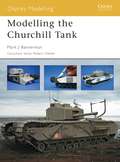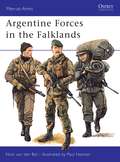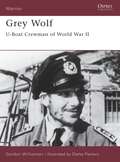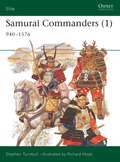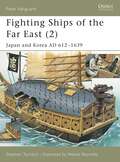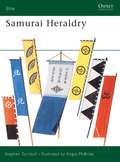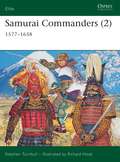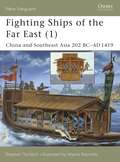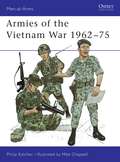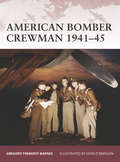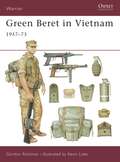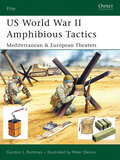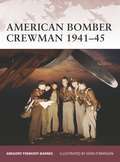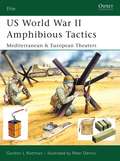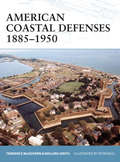- Table View
- List View
Modelling the Churchill Tank (Osprey Modelling)
by Mark Bannerman Dinesh NedThe Churchill saw much action in World War II, from the 1942 raid on Dieppe, through the heat of the battles in North Africa, to the bitter fighting in Normandy 1944 and into the Reich in 1945. Despite criticism that it was slow and outmoded in terms of design, it proved itself a rugged and solid vehicle.This title provides a comprehensive guide to modelling the Churchill across a range of skill levels, featuring challenging builds of numerous marks and variants, including brideglayers, flame-throwers (such as the Crocodile) and customised assault vehicles (such as the spigot-mortar armed ARVE).
Tribes of the Sioux Nation (Men-at-Arms)
by Jonathan Smith Michael G JohnsonThe horse culture of the tribes of the High Plains of North America lasted only some 170 years; yet in that time the sub-tribes of the Teton or Western Sioux people imprinted a vivid image on the world's imagination by their fearless but doomed fight to protect their hunting grounds from the inevitable spread of the white man. This text outlines the history, social organization, religion and material culture of the Santee, Yankton and Teton Sioux; rare early photographs include portraits of many of the great war chiefs and warriors of the Plains Indian Wars, and eight detailed plates record details of Sioux traditional costume.
Imperial Japanese Navy Submarines 1941–45 (New Vanguard)
by Tony Bryan Mark StilleDuring World War II the Imperial Japanese Navy was at the forefront of submarine technology. It fielded the largest pre-nuclear submarines in the world, some capable of carrying floatplane bombers, which operated alongside fast combat vessels and midget submarines, all equipped with the best torpedoes available. The Japanese submarine fleet should have been an awe-inspiring force but, despite playing a crucial scouting role and enjoying several notable successes, it was surprisingly ineffective. Using unique color plates, Mark Stille describes the astounding technical advances of this range of vessels, and the wartime tactics responsible for their failure.
Argentine Forces in the Falklands (Men-at-Arms)
by Paul Hannon Nick van der BijlThe announcement of the imminent withdrawal of the British Royal Navy's ice patrol ship HMS Endurance in early 1982 prompted the Argentinian Junta in Buenos Aires to plan a military grab of the Falklands-a siege they assumed would succeed with little resistance. Such an adventure was attractive as a distraction for the Argentine public at a time of political unease. In April the Junta, led by Gen. Leopoldo Galtieri, made its move. This fascinating book examines the history, organization and equipment of the Argentine forces that battled for control of this remote British outpost.
German Military Police Units 1939–45 (Men-at-Arms)
by Ronald Volstad Gordon WilliamsonThe military policeman must be one of the least appreciated yet most indispensable military figures in modern history. In the mobile warfare of the 20th century no army could keep its vital supply routes open without the military policeman. This book documents the organisation, uniforms and insignia of the many and varied German military police units of World War II. Their duties included traffic control; maintaining military order and discipline; collection and escorting prisoners of war; prevention of looting; disarming civilians; checking captured enemy soldiers for documents; collection of fallen enemy propaganda leaflets and providing street patrols in occupied areas.
Grey Wolf: U-Boat Crewman of World War II (Warrior)
by Darko Pavlovic Gordon WilliamsonThe scourge of Allied shipping during World War II, the U-Boot Waffe was one of the most feared components of Hitler's war machine, yet the Kriegsmarine was the least political branch of the Third Reich. The sailors of the U-boat arm were courageous, highly skilled seamen, who fought a war in the toughest conditions: subject to immense tension, and forced to cope with the challenges of the Atlantic, life for a U-boat recruit was far from easy. This title explores the life of a typical U-boat crewman, from recruitment, through training and service conditions, to combat experience throughout the war. Illustrated with many previously unpublished images, this book offers a fresh insight into the experiences of the men in Dönitz's legendary 'wolf packs'.
German Seaman 1939–45 (Warrior)
by John White Gordon WilliamsonWhen re-armament came after World War I, the German Navy was forced to build anew, so the Reichsmarine and its successor, the Kriegsmarine, found itself in possession of some of the most modern, powerful and technically advanced vessels in the world. Germany was very selective in picking her sailors and the quality of manpower skill levels was thus very high. This book charts the recruitment, training, service conditions and combat experiences of a typical World War II German sailor, focusing on the main branches of the Navy, as well as the last ditch combat units thrown into action as infantry in the final days of the war.
Samurai Commanders: 940–1576 (Elite)
by Stephen Turnbull Richard HookThe samurai were the military elite of medieval and early modern Japan, and the men who led them were hailed as the very greatest, most heroic and most honourable of all samurai warriors. This first of two books examines the lives, equipment, battles and wider roles of the samurai commanders between 940 and 1576, the period from the emergence of the samurai to the triumph of Oda Nobunaga, who set Japan on the road to reunification. The styles of armour and weaponry of the samurai changed considerably during this time and this book visually recreates some of the most famous samurai commanders.
Fighting Ships of the Far East: Japan and Korea AD 612–1639 (New Vanguard)
by Stephen Turnbull Wayne ReynoldsOver the centuries, naval relations between Japan and Korea appear to have alternated between peaceful trade and outright hostility. However, this impression can be misleading, as much of what passed for mercantile activity was in fact conducted by Japanese pirate fleets, who pillaged the coasts of Korea and China in a long-lasting tradition that culminated in the greatest pirate raid of all: Hideyoshi's invasion of Korea in 1592. This was the conflict that involved Ming China and almost dragged in Siam. It also led to Korea developing East Asia's most famous warship: the legendary turtle ship, which is described for the first time in full technical detail in this book.
Samurai Heraldry (Elite)
by Stephen Turnbull Angus McBrideThe dazzling spectacle presented by the armies of medieval Japan owed much to the highly developed family and personal heraldry of samurai society. From simple personal banners, this evolved over centuries of warfare into a complex system of flags worn or carried into battle, together with the striking 'great standards' of leading warlords. While not regulated in the Western sense, Japanese heraldry developed as a series of widely followed practices, while remaining flexible enough to embrace constant innovation. Scores of examples, in monochrome and full colour, illustrate this fascinating explanation of the subject by a respected expert on all aspects of samurai culture.
Samurai Commanders: 1577–1638 (Elite #128)
by Stephen Turnbull Richard HookThis second volume about Japan's samurai commanders covers the generals of the later years of the Age of the Warring States, a period when only the most able leaders survived. This was a time when the prowess of a commander was measured as much by his strategic and organizational abilities as by his individual fighting skills and he was expected to give as great a show of strength in the council chamber as on the battlefield. This book discusses the lives, battles and wider roles of talented commanders such as Oda Nobunaga and Toyotomi Hideyoshi great men who stood out prominently due to their elaborate suits of armour and helmets, their stunning personal heraldry and their great armies.
Fighting Ships of the Far East: China and Southeast Asia 202 BC–AD 1419 (New Vanguard)
by Stephen Turnbull Wayne ReynoldsFighting Ships of the Far East (1) adds enormously to the hitherto small corpus of knowledge about a fascinating and little known subject. Using detailed descriptions, accurate cutaway plates and reliable historical examples, this book covers the history of Chinese ship design and naval warfare from the beginning of the Han dynasty to the first few years of the Ming dynasty. The epic battle of Lake Poyang in in 1363, won by the man who was to become the first Ming Emperor, is also detailed.
War in Japan 1467–1615 (Essential Histories)
by Stephen TurnbullIn 1467 the Onin War ushered in a period of unrivalled conflict and rivalry in Japan that came to be called the Age of Warring States or Sengoku Jidai. In this book Stephen Turnbull offers a masterly exposition of the Sengoku Jidai, detailing the factors that led to Japan's disintegration into warring states after more than a century of peace; the years of fighting that followed; and the period of gradual fusion when the daimyo (great names) strove to reunite Japan under a new Shogun. Peace returned to Japan with the end of the Osaka War in 1615, but only at the end of the most violent, turbulent and cruel period in Japanese history.
Armies of the Vietnam War 1962–75 (Men-at-Arms)
by Mike Chappell Philip KatcherPhilip Katcher provides an overview to the conflict that engulfed Vietnam following the division of the country into two along the 17th Parallel in 1954. The uniforms and insignia of the US forces, including the army, Special Forces, air force, navy and marine corps, are dealt with in detail, together with those of the ARVN, the Allied Forces (such as the Royal Thai Army and Korean troops), and also the Communist NLF (Viet Cong) and NVA forces. Mike Chappell's colourful artwork provides plenty of detail to accompany this authoritative text.
American Bomber Crewman 1941–45 (Warrior)
by Gregory Fremont-Barnes Seán Ó’BrógáinGregory Fremont-Barnes examines the lives of the American Bomber Crewmen of the Eighth Air Force, 'The Mighty Eighth', who manned, maintained and repaired the Boeing B-17 Flying Fortresses and the B-24 Liberators that flew from the airfields of England. He highlights the physical and psychological strain placed on these men, who required brute strength to control the aircraft on long bombing missions and extraordinary endurance to fly for hours at 20,000 feet at temperatures below freezing in unpressurised cabins. In addition to this, with Luftwaffe fighters and anti-aircraft fire to contend with, it required incredible skill and some luck to return from a mission unscathed. This book is a fitting tribute to these often uncelebrated heroes who took the war deep into the Third Reich, as well as a fascinating historical account of their experiences.
Green Beret in Vietnam: 1957–73 (Warrior #28)
by Gordon L. Rottman Kevin LylesVietnam was the US Special Forces most complex and controversial mission, one that began in 1957 and ended in 1973. Camp strike forces, mobile strike forces, mobile guerrilla forces, special reconnaissance projects, training missions and headquarters duty provided vastly differing experiences and circumstances for SF soldiers. Other fluctuating factors were the terrain, the weather and the shifting course of the war itself. Gordon Rottman examines the training, life, weapons and combat experiences of the Special Forces soldier in this challenging environment.
US Combat Engineer 1941–45 (Warrior #147)
by Adam Hook Gordon L. RottmanAt its peak in World War II, the United States Army contained over 700 engineer battalions, along with numerous independent brigades and regiments. The specialized soldiers of the Engineers were tasked with a wide variety of crucially important tasks including river bridging, camouflage, airfield construction, and water and petroleum supply. However, despite their important support roles, the engineers were often employed on the front lines fighting beside the general infantry in the desperate battles of the European theatre. This book covers the role of these soldiers, from their recruitment and training, through their various support missions and combat experiences, forming an account of what it was truly like to be a combat engineer in World War II.
US Army Air Force (Elite #46)
by Gordon L. RottmanIn June 1941 the US Army's air organisations were consolidated under a single command, the Army Air Forces or AAF. Its expansion was rapid and massive, and its contribution to the war effort was substantial. Books abound describing the AAF's impressive combat record, but little has been published to record what the men inside the machines wore to stay alive and effective in the air and on the ground, or, as often as not, in the water. Gordon L. Rottman's detailed treatment discusses the flying clothes, accessories and equipment worn and used by individual airmen fighting their often desperate battles in the sky.
US World War II Amphibious Tactics: Mediterranean & European Theaters (Elite #144)
by Gordon L. RottmanThe US armed forces pioneered amphibious warfare in the Pacific and by the time of the D-day landings they had perfected the special equipment and tactics necessary for this extraordinarily difficult and risky form of warfare. This fact-packed study details the doctrine, equipment and tactics that evolved between the North African landings of November 1942 and those in the South of France in August 1944, and illustrates many aspects of the physical realities of assault landings through the use of photos, diagrams and color plates.
American Bomber Crewman 1941–45 (Warrior)
by Gregory Fremont-Barnes Seán Ó’BrógáinGregory Fremont-Barnes examines the lives of the American Bomber Crewmen of the Eighth Air Force, 'The Mighty Eighth', who manned, maintained and repaired the Boeing B-17 Flying Fortresses and the B-24 Liberators that flew from the airfields of England. He highlights the physical and psychological strain placed on these men, who required brute strength to control the aircraft on long bombing missions and extraordinary endurance to fly for hours at 20,000 feet at temperatures below freezing in unpressurised cabins. In addition to this, with Luftwaffe fighters and anti-aircraft fire to contend with, it required incredible skill and some luck to return from a mission unscathed. This book is a fitting tribute to these often uncelebrated heroes who took the war deep into the Third Reich, as well as a fascinating historical account of their experiences.
Green Beret in Vietnam: 1957–73 (Warrior)
by Gordon L. Rottman Kevin LylesVietnam was the US Special Forces most complex and controversial mission, one that began in 1957 and ended in 1973. Camp strike forces, mobile strike forces, mobile guerrilla forces, special reconnaissance projects, training missions and headquarters duty provided vastly differing experiences and circumstances for SF soldiers. Other fluctuating factors were the terrain, the weather and the shifting course of the war itself. Gordon Rottman examines the training, life, weapons and combat experiences of the Special Forces soldier in this challenging environment.
US World War II Amphibious Tactics: Mediterranean & European Theaters (Elite)
by Peter Dennis Gordon L. RottmanThe US armed forces pioneered amphibious warfare in the Pacific and by the time of the D-day landings they had perfected the special equipment and tactics necessary for this extraordinarily difficult and risky form of warfare. This fact-packed study details the doctrine, equipment and tactics that evolved between the North African landings of November 1942 and those in the South of France in August 1944, and illustrates many aspects of the physical realities of assault landings through the use of photos, diagrams and color plates.
Vietnam Riverine Craft 1962–75 (New Vanguard #128)
by Hugh Johnson Gordon L. RottmanIn 1965 the military situation in the Mekong River Delta of southern Vietnam had deteriorated to such a degree that the decision was made to commit a joint US Army and Navy Mobile Riverine Force to the area. This force was unique in its composition, mission, and the means by which it operated – riverine craft. Comprising the Army's 2d Brigade, 9th Infantry Division, and the Navy's River Assault Flotilla One, it used a variety of watercraft, including heavily modified landing craft, purpose-built patrol boats, and a whole host of auxiliary and support craft. This book explores those craft, and also gives an account of Task Force Clearwater, a much smaller operation in the extreme northern part of South Vietnam.
American Coastal Defenses 1885–1950 (Fortress #44)
by Peter Bull Terrance McGovern Bolling SmithIn the late-19th century, with the advances in technology and the increase in America's economic stature, a new round of fortification building began in the United States and its overseas territories. Locations such as Portland, Boston, New York, Baltimore, Charlestown, Savannah, Key West, Los Angeles and San Francisco were all extensively fortified. This book provides a concise introduction to the design, development and purpose of American coastal defenses in the "modern" era (1885–1950), a period defined by the use of concrete, steel, and powerful breech-loading rifles. It covers the emplacements, weaponry, equipment, and people that defended their country in times of great change and uncertainty.
Mirage III vs MiG-21: Six Day War 1967 (Duel #28)
by Jim Laurier Shlomo AloniAlthough the opposing forces of the Six Day War were both flying comparable third-generation Mach 2 jet fighters, the pilots were trained to different standards, and were expected to utilize different tactics. Using the latest research, first-hand accounts, and specially commissioned artwork, Shlomo Aloni tells the dramatic story of the dogfights in the skies over the Middle East.
